Château de la Gravelle (Certified Organic) – Pays Nantais

The Estate
Formerly a 300 hectare property that was split up during the French Revolution, Château de la Gravelle now spans 15 hectares and is located in the town of Gorges, France in the heart of the Sèvre et Maine appellation. The estate, managed by Véronique Günther Chéreau, is home to buildings that date back to Louis XIII, including its classic windmill (featured on the bottle label) which is a typical feature of the Nantes region. The vineyards have a unique soil structure composed of volcanic rock (or gabbro), shale, and other sedimentary rock, a feature that gives the resulting wines their elegance and exceptional bouquet. Starting in 2010, the estate converted to an organic operation, and continues to employ organic methods to this day.
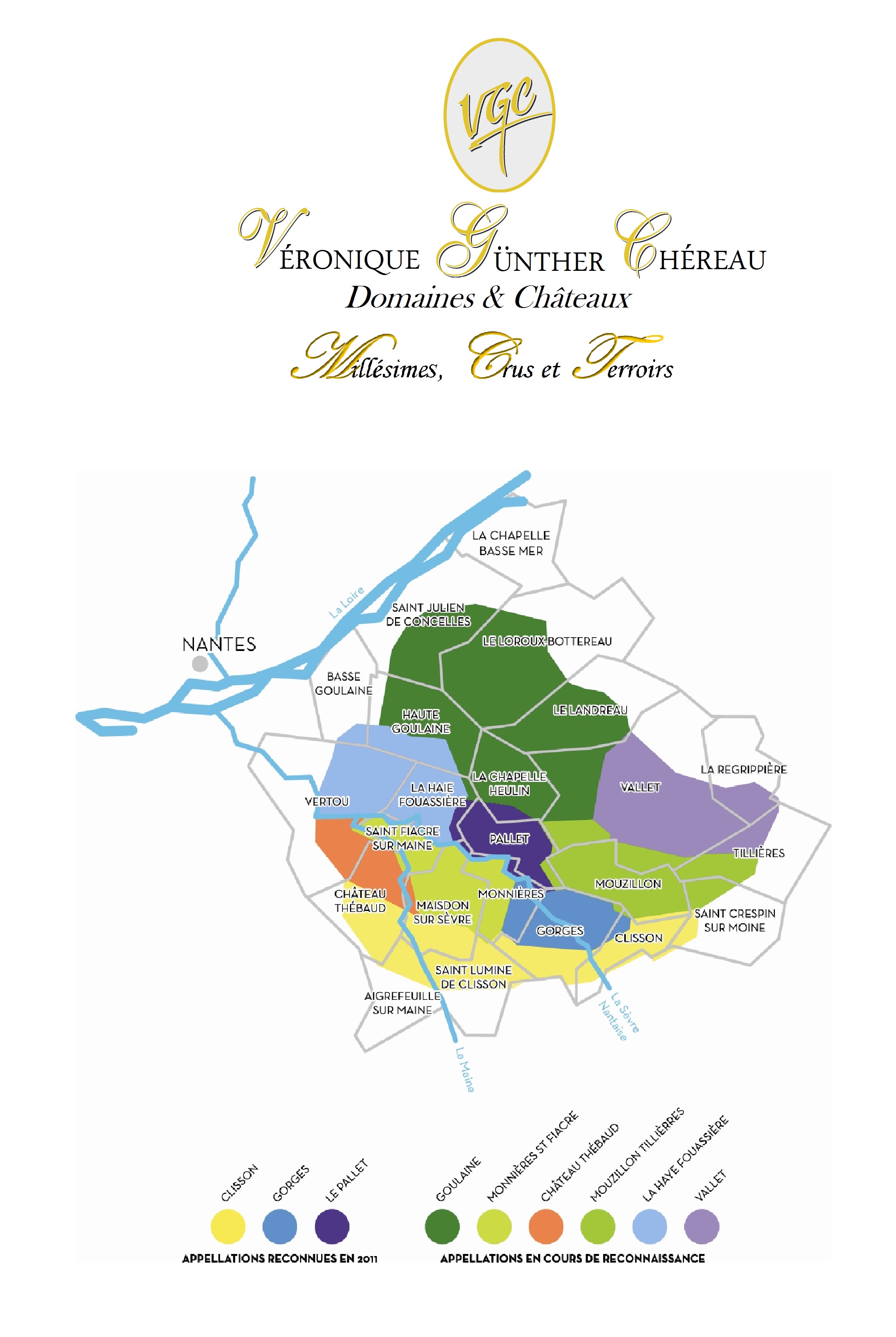
Map of Muscadet appellations

Muscadet Sèvre et Maine
The Vines: The Melon de Bourgogne was first planted in the Nantes area after the frost of 1709 that wiped out all of the vines in the region. This Burgundian grape variety has found its vocation by adapting wonderfully to the Nantes terroir.
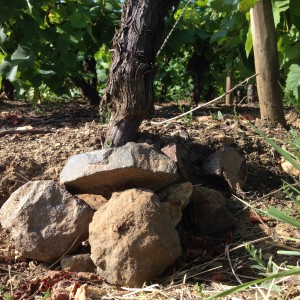
The volcanic rock soil of Chateau de la Gravelle
The Soil: The vineyard of the Château de la Gravelle has an uncommon terroir; its subsoil is composed of a volcanic rock called gabbro and covered with a layer of clay.
Vinification: The wine is vinified on its lees, or “sur lie.” The lie, or dead yeast cells, is the result of natural sedimentation of the solid elements of the wine. After alcoholic fermentation, the wine rests on its lees throughout the winter until bottling at the end of March. It is never racked, which allows the conservation of a small quantity of carbon dioxide, giving the wine a fine beading, a quality that is so exquisite and appreciated by connoisseurs.
Tasting Notes: This Muscadet Sèvre et Maine is a classic wine of the region with much body and liveliness. It is best served with shellfish such as lobster and crawfish, and most other seafood as well. It is also highly enjoyable on its own as an aperitif. Because of its structure, it goes well with buttery dishes.
Château de Targé (Organic)

History
In 1655, Phelippeaux de Ponchartrain, the personal secretary to King Louis XIV of France, acquired a hunting lodge near the forests of the Royal Abbey of Fontevraud, along with the hilltop next to it. Since then, the property has been kept in the family, and each generation contributed to its construction and reputation. Henri Allain-Targé brought French politicians of the 3rd Republic like Gambetta and Villemain to the Chateau. Then, with the marriage of Geneviève Allain-Targé to Charles Ferry, brother of Jules Ferry (well known in France for his efforts in making school mandatory and free for all French youth), the Chateau became the privileged residence of the Ferry’s. Fresnette – their only descendant – and her husband Edgard Pisani, then Minister under de Gaulle, together restored the Château after all the damage done by the two World Wars.
Their son, Edouard Pisani-Ferry, agricultural engineer in winemaking, inherited the Château in 1976. He started by building a modern winery with thermo-regulated tanks, and then in the 1990’s expanded the vineyard by buying and exchanging terroirs in order to have the quality of land he thought the Château deserved. During this time, he also started to utilize environment-friendly methods for cultivation and vinification. Since 2000, he has been a member of the Terra Vitis association, which is committed to sustainable agriculture. Today, the estate covers an area of about 24 hectares (60 acres).

Location
The vineyard is grouped together on the coteau above the Château on the border of AOC Saumur-Champigny, and is located on the best soils of Parnay towards the Loire. The names of the parcels give a clue as to the maturity of the area: Clos Saint-Père, Clos du Moulin, Clos Saillant, Clos Vert…
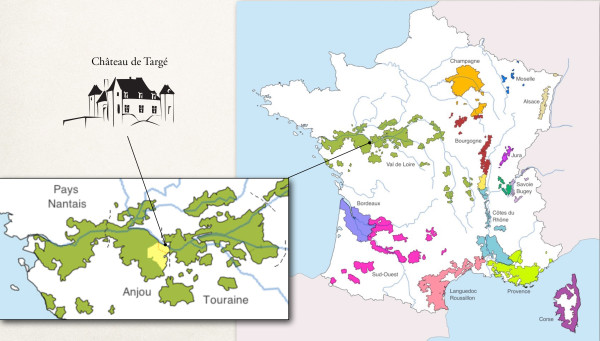
Location Map
Climate
The name Saumur Champigny, after Latin “Campus Ignis,” means “Fire Field.” Indeed, the climate of the region is half oceanic, therefore quite mild and of steady temperature, but there is a microclimate over Saumur and Chinon, warmer and drier than the rest of the Loire Valley, with only 525 mm of yearly rainfall (national average being 900 mm). It enables the estate to produce exceptional red wines, which need more sun than white wine. This microclimate is explained by the hills that protect the region from most of the large clouds coming from the ocean, located 150 km southwest.
Soil
The soil is composed of clay and limestone (from superior cretaceous), while the subsoil results from sediment which settled 80-90 million years ago, allowing the formation of a hard chalk, white or light ochre: freestone. This composition, similar to a sponge, enables the rain to moisturize the subsoil without drowing it in water.
Fun Fact: The limestone from this terroir was used for the construction of hundreds of Chateaux along the Loire towards Nantes, as well as in England. The removal of the stone created caves which were ideal for the conservation of wine because of the fresh air and perfectly constant temperature.
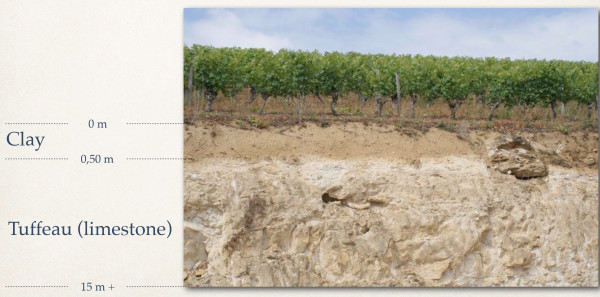
The soils from upper Turonian (Jurassic)
Grape Varieties
All of the grapes planted are noble varietals of the Loire Valley: The Cabernet Franc (85%) from Saumur-Champigny, which is known for its ideal development on clay and limestone soils with a northern climate, as well as its delicate and elegant wines; the Chenin Blanc (15%) from the Saumur Blanc and Coteaux de Saumur: very typical of the region, its big personality wonderfully represents the soils of the vineyard. These two varietals are planted at a density of at least 5,000 vines per hectare.
Sustainable Development
The domain has been invested in sustainable development for more than a decade now, and has been awarded each year since 2000 when it joined the Terra Vitis label. Progressively since 2009, all of the vines have been cultivated without weed killer, insecticide, or chemical fertilizer. In 2017, the domaine began conversion to organic farming, with 2020 being the first certified organic vintage.
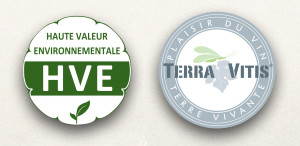

Saumur-Champigny Cabernet Franc
Appellation: AOC Saumur-Champigny
Soil: Clay-limestone from upper Turonian ( Jurassic): the microclimate around Saumur is the hottest and driest spot in the entire Loire Valley.
Grape Varieties: 100% Cabernet Franc
Yield: 50-60 hl/ha
Vineyard Management: Grassed-through, ploughed vineyards: no use of fertilizers, just compost. The aim is to produce naturally healthy grapes (thinning out the grapes and leaves for aeration, etc.), adhering strictly to the rules of sustainable agriculture.
Age of Vines: 10-40 years old
Harvest: Mechanical, in October, at a medium yield of 45 hl/ha in order to ensure concentration of flavors in the grapes
Vinification: In thermo-regulated stainless steel vats following a thorough double sorting on receipt. Use of maceration, aeration, and temperature control in the search for harmony, fruit, elegance, and depth.
Maturation: In thermo-regulated stainless steel vats, 9 months of maturation before bottling.
Tasting Notes: A ruby red Cabernet Franc, rich and fruit filled on the nose, backed up with soft tannins. Much appreciated in restaurants as it goes equally well lightly spiced fish or meat.
Cellaring Potential: 3-10 years
Serving Suggestions: Serve at around 17°C (60°F) with fresh peppered goat cheese, roasted pork, duck maigret, beef fondue, or even fish to accompany the lightest vintages (2007, 2012, 2013)

Saumur-Champigny Cabernet Franc Cuvée Ferry
Appellation: AOC Saumur- Champigny
Production Area: 3 ha
Soil: Clay-limestone from upper Turonian (Jurassic). The microclimate around Saumur is the hottest and driest spot in the entire Loire Valley.
Grape Varieties: Cabernet Franc
Yields: 35 / 40 hi per ha
Viticulture: Grassed-through and cultivated soils; no fertilizer, just compost. The aim is to produce naturally healthy bunches of grapes (thinning out of the grapes and leaves for aeration), adhering strictly to the rules of sustainable agriculture.
Vinification: In thermoregulated stainless steel vats following a thorough double sorting on reception. Use of maceration, pigeage (a device with railings pushes the skins into the juice) aeration and temperature control in the search for harmony and fruit, strength and depth.
Maturation: In thermoregulated stainless steel vats and partly in the oak barrels which have been used for the Quintessence. Bottled before end of the following year.
Tasting Notes: This cuvée is made from Cabernet Franc old vines and is partly oaked. The wine has a beautiful garnet color, a nose of dark fruits, and a clean and structured attack on the palate.
Cellaring Potential: Best to wait at least two or three years, for the next ten years or more.
Serving Suggestions: To enjoy at around 60°F with a special meal (T-bone sirloin, duck maigret…)

Saumur Chenin Blanc Les Fresnettes
Appellation: AOC Saumur Blanc
Production Area: 3 ha
Soil Type: Clay-limestone from upper Turonian (Jurassic). The microclimate around Saumur is the hottest and dryest spot in the entire Loire Valley.
Grape Varieties: 100% Chenin Blanc
Average Yield: 30-35 hl/ha
Viticulture: Grassed-through and cultivated soils; no fertilizer, just compost. The aim is to produce naturally healthy bunches of grapes (thinning out the grapes and leaves for aeration), adhering strictly to the rules of sustainable agriculture.
Harvest: Hand picking with 2 or even 3 selections. The grapes are very ripe, but the focus is to make a dry white.
Vinification: Direct filling in a pneumatic press, and once the must is settled, the fermentation takes place in 400 liters oak barrows (a third new, a third of one wine and a third of two wines).
Aging: The fermentations last weeks in barrel; as a whole the wine stays in them for 10 months, with partial or total malolactic fermentation. The stirring of the lees are made according to the vintage, so as to give body to the wine.
Cellaring Potential: The Chenin Blanc is well known for its longevity; 10 years or much more. Many do not wait to appreciate the fantastic aromas of fresh white fruits.
Tasting Notes: This delicious, dry Chenin Blanc was selectively harvested by hand from reduced yield vines, then fermented and and matured entirely in oak barrels resulting in a very classy, rich wine, with attractive hints of peach in the nose.

Saumur-Champigny Cabernet Franc Quintessence
Appellation: AOC Saumur-Champigny
Production Area: 1.50 ha
Soil: Clay-limestone from upper Turonian (Jurassic); the microclimate around Saumur is the hottest and dryest spot in the entire Loire Valley.
Grape Varieties: Old vines of Cabernet Franc (over 40 years old)
Yield: 25/30 hl per ha
Viticulture: Grassed-through and cultivated soils; no fertilizer, just compost. The aim is to produce naturally healthy bunches of grapes (thinning out the grapes and leaves for aeration), adhering strictly to the rules of sustainable agriculture.
Vinification: Small thermo-regulated stainless steel 50 hl vats are used as they provide perfect temperature control and proportion of skin to juice. Before the end of fermentation, racking is done directly into new oak 400 liter barrels.
Aging: The fermentations (alcoholic then malolactic) end entirely in the barrels. Aging lasts about 12-15 months, followed by blending and then the wine is bottled the following spring.
Cellaring Potential: 15 years or more
Tasting Notes: This special reserve is produced from old vines planted on a remarkable clay-limestone subsoil. The grapes are harvested just before becoming overripe. The fine and sugary tanins of the new oak barrels contribute to make the wine rich and subtle.
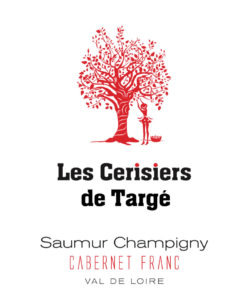
Saumur-Champigny Cabernet Franc Les Cerisiers de Targé
Appellation: AOC Saumur-Champigny
Grape Varieties: 100% Cabernet Franc
Yield: 50 hl/ha
Soil: Clay soil on Tuffeau subsoil. This rock is a sedimentary limestone formation from the Turonian age, 90 million years ago. The roots grow down in the top 70 to 90 cm of clay (25-35 inches), feeding the young vines, then get around the Tuffeau to find water and new nutrients that are naturally brought up through the rock by capillarity.
Climate: The meso-climate of the Saumur region is the hottest and driest in the entire Loire Valley.
Vinification: The grapes are put in stainless steel tanks with thermoregulation to start with a cold maceration, then a controlled temperature fermentation. Aerations of the wine and temperature are modulated depending on the vintage, with the aim of producing a harmonious, fruity, and elegant wine while keeping texture and volume on the palate.
Aging: In stainless steel tanks, for a bottling in June.
Alcohol: 13-13.5%, depending on the vintage
Cellaring: Gets to its optimum between 1 and 4 years and will develop beautifully up to 6-8 years.
Serving Temperature: Around 15°C (59°F)
Food Pairing: Pairs well with light but flavorsome dishes, such as steak with shallots, turkey and orange, skate with capers, and monkfish in mustard sauce. Perfect also with fresh peppered goat cheese — St. Maure de Touraine being the winemaker’s favorite.
Tasting Notes: Fruit-filled Cabernet Franc, lightly spiced on the nose and backed-up with soft tannins and ripe redcurrant and blackberry aromas in the mouth. Much appreciated in restaurants, as it complements equally spiced fishes, meat, and light dishes.

Chinon De Targé Cabernet Franc
Overview: After a massive attack of mildew in 2018 which ravaged the vineyard, then still in the midst of the transition to organic agriculture, the estate purchased grapes from Chinon from an excellent terroir. This is a very typical Chinon in a sumptuous vintage.
Grape Variety: 100% Cabernet Franc
Average Yield: 45 hl/ha
Soil: Heavy clays and quartz sands on the surface on a limestone bed at a depth of 1.2 meters.
Climate: This well-draining plot is located on the north face of the Chinon hill, which allowed it to keep a lot of freshness despite the great heat of the 2018 vintage.
Viticulture: Worked and grassed soils, in the middle of bocage hedges and biodiversity zones recreated every year since 2005. Strict controls have been imposed for the Terra Vitis labels since 2000, High Environmental Value since 2014, and organic agriculture since 2017.
Vinification: For this unique vintage, the harvest was done by hand and the winemakers used the same methods as for the Cuvee Ferry; the grapes are places in thermo-regulated steel vats for a cold maceration, followed by a temperature-controlled fermentation. Very little pumping over in order to limit the extraction which was done by itself, several airings and rather low temperatures in order to seek the complexity, structure and power of these grapes.
Aging: Aging is done in steel vats and the wine is bottles at the end of the following year.
Serving Temperature: 17°C
Food Pairings: This cuvee will adapt perfectly to slightly or strongly spiced cuisines, to grilled food accompanied by sauteed vegetables, or to winter dishes simmered for long hours.

Chenin De Targé Saumur Blanc
Appellation: AOC Saumur Blanc
Location: The vineyard is situated on a small mound located 2 to 3 meters above the rest of the plateau, which protects the vines from frost and ensures good exposure to the winds.
Soil: Silty and flinty clays 80 cm deep, then Turonian limestone in the subsoil.
Grape Varieties: 100% Chenin
Average Yield: 50 hl/ha
Viticulture: Strict controls have been imposed for the Terra Vitis labels since 2000, High Environmental Value since 2014, and Organic Agriculture since 2017.
Harvest: Manual harvest quite early to obtain freshness and lightness in the grapes.
Vinification: Direct pneumatic pressing of the grapes then settling in vats. Fermentation takes place in barrels for 4 weeks, then we rack off to make room for the Fresnettes in the barrels. Bottling takes place in the spring to lock in the fresh citrus flavors in the bottle, and 6 months later it is available for sale.
Food Pairings: Drink with seafood, oysters, fresh cheeses or quite simply as an aperitif, on the beach or on the terrace.
Cellaring: Consume within two years to preserve the aromas, salinity, and freshness.
Serving Temperature: 5°C, chilled is best!

Saumur Brut Rosé Méthode Ancestrale
Overview: The subsoil, 90 million years old, was made at the same time (Upper Cretaceous) as that of Vouvray and Champagne. This Crémant-style Brut is pure Cabernet Franc that highlights all the freshness and fruity aromas typical of the grape variety, for a festive wine very popular at weddings and other celebrations.
Soil: Clay over tuffeau (Turonian limestone that was formed over 90 million years ago). The roots grow a depth of 90 cm into the clay, nourishing the young plants, after which they circle around the tuffeau to find other nutrients and water, which are brought by root capillarity through the rock.
Climate: The Saumur mesoclimate is the hottest and driest in the entire Loire Valley.
Production Area: 0.5 ha
Grape Variety: 100% Cabernet Franc
Annual Production: 3,000 bottles
Yield: 50 hl/ha
Viticulture: Soils are ploughed and grassed; aeration by thinning and leaf stripping; natural compost is used. Strict controls have been imposed for the Sustainable Agriculture Terra Vitis labels since 2000, HVE – High Environmental Value since 2014, and Organic Agriculture since 2017.
Vinification: Manual harvest into openwork boxes; only perfectly ripened grapes are selected to give the wine a fresh and fruity character. Direct pneumatic pressing, slow and gentle so as not to extract bitterness. Fermentation is done in vats.
Aging: The tirage is done early in winter, then the bottles are allowed to rest on slats for a minimum of one year.
Alcohol: 12.5%
Dosage: 3-5 g/l
Cellaring: To be consumed within 2 years.
Serving Suggestion: Serve chilled as an aperitif, or as an accompaniment to dinner. It is a wine that we also like to drink without accompaniment to taste the fruit in all its simplicity.
Domaine Daniel Crochet (Organic) – Central Vineyards
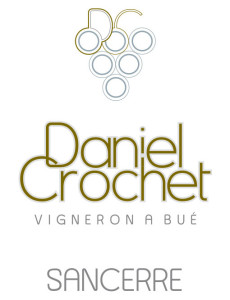
The Estate
This domaine is in its fourth generation; Daniel Crochet took over the family business in 1996 after studying viticulture and oenology at the Lycée Wine Avize in the Marne.
Since 1996, operations have expanded to today where the vineyard covers an area of 9.15 hectares, 5.92 hectares of which are planted with Sauvignon Blanc, and 3.23 hectares with Sauvignon Pinot Noir.
The plots are located in the towns of Sancerre and Bué–all AOC Sancerre. The soils are composed of “terres blanches”, or clay-limestone, and “caillottes”, or pebbly limestone.
Three important viticultural techniques are employed on the estate: ploughing, ENM (the practice of permitting natural grass to grown among the wines), and cultivation of grass between the rows of vines. This alone represents 70% of the property with the aim to preserve soil quality and avoid erosion as well as limiting the yields of the vines in order to obtain the maximum concentration in the grapes. In addition, a conscientious and environmentally responsible program of pest and disease control is practiced throughout the estate.
Sancerre Blanc
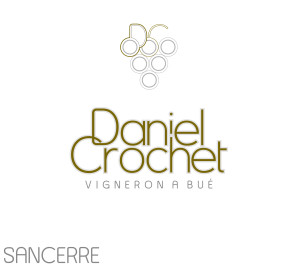
Terroir: “Les Terres blaches” or clay-limestone soils, and “Les caillottes”, very stony and chalky.
Production Area: 5.2 hectares
Grape Variety: 100% Sauvignon Blanc
Average Age of the Vines: 8-45 years old
Growing Method: Guyot simple
Viticulture: The vineyard has been in conversion to certified organic agriculture since 2020.
Harvest: The grapes are harvested manually, sorted, then transported to the presser by conveyer belt.
Vinification: Sequential pneumatic pressing of whole grapes. A static settling of approximately 72 hours is carried out at low temperature. Fermentation in vats between 16-22°C.
Aging: On the fine lees for 6-8 months. Light fining and filtration, then tartaric stabilization. Bottling on the estate.
Tasting Notes: Pale gold color with green reflections. Fresh and fruity on the nose, and a pure expression of the grape varietal on the palate.
Food Pairings: Goat cheeses, white fish, and lighter dishes like carpaccio
Serving Temperature: Serve at 10-12°C when consumed as an aperitif, and 12-14°C with meals.
Sancerre Blanc Cuvée Prestige
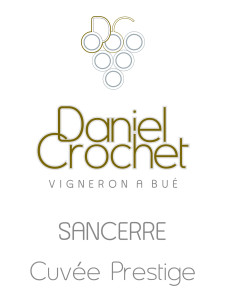
Overview: This cuvee is produced from a blend of 3 different plots of older vines. The plots are situated in the towns of Sancerre and Bué, all AOC Sancerre.
Soil: Pebbly limestone
Production Area: 0.4 hectares
Grape Variety: 100% Sauvignon Blanc
Average Age of the Vines: 41-44 years old
Harvest: The grapes are harvested manually, sorted, then transported to the presser by conveyer belt.
Viticulture: The vines are pruned in simple Guyot. The vineyard is in organic conversion since 2020.
Vinification: Sequential pneumatic pressing of whole grapes. A static settling of approximately 72 hours is carried out at low temperature. Fermentation in vats between 16-22°C with the use of indigenous yeasts.
Aging: On the fine lees for 6-9 months with regular batonnage. Light fining and filtration, then tartaric stabilization. Bottling on the estate.
Tasting Notes: Pale gold color. The full bouquet has pear, citrus, and mineral tones that open instantly. This is a highly aromatic wine with an excellent balance between soft and dry on the palate, and an almost lush finish of white flowers like lilac mixed with ripe white fruit. A bright jewel.
Food Pairings: Scallops, oysters, goat cheese, etc.
Serving Temperature: Serve at 10-12°C when consumed as an aperitif, and 12-14°C with meals.
Sancerre Blanc Plante des Prés
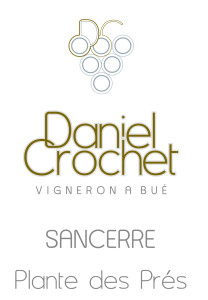
Production Area: 0.27 hectares
Grape Variety: 100% Sauvignon Blanc
Exposition: South
Soil: Very crumbly limestone
First Planting: 1965
Harvest: The harvest is manually done, sorted and transported to the press by conveyor belt (whole bunch pressing).
Viticulture: The vines are pruned in simple Guyot. The vineyard is in organic conversion since 2020.
Vinification: Sequential pneumatic pressing of whole grapes. A static settling of approximately 72 hours is carried out at low temperature. Fermentation in vats between 16-22°C with the use of indigenous yeasts.
Aging: On the fine lees for 8-12 months with regular batonnage. Natural clarification and light filtration. Bottling on the estate.
Tasting Notes: The bouquet is a lovely, delicate prelude to the round notes on the palate. This Sancerre is richly aromatic while having the unique characteristic of being light as a feather without lacking character and depth.
Food Pairings: Oysters, shellfish, white fish, fresh or aged goat cheese.
Serving Temperature: 10-12°C when served as an aperitif, or 12-14°C as accompaniment to a meal.
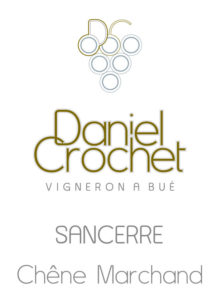
Sancerre Blanc Chêne Marchand
First Planting: 1965
Harvest: The harvest is manually done, sorted and transported to the press by conveyor belt (whole bunch pressing).
Production Area: 0.6 hectares
Grape Variety: 100% Sauvignon Blanc
Exposition: South
Soil: Limestone, called “caillottes”
Viticulture: The vines are pruned in simple Guyot. The vineyard is in organic conversion since 2020.
Vinification: Sequential pneumatic pressing of the whole grapes. A static settling of approximately 72 hours is carried out at low temperature. Fermentation in 600-liter vats at temperatures between 16-22°C. Indigenous yeasts.
Aging: On the lees with regular battonage for a period of 8-12 months depending on the vintage. Natural clarification and light filtration. Bottles on the estate.
Tasting Notes: The pale gold color lends a ripe appearance to this wine. The nose expresses the terroir with a frank purity. The finish is rich with a hint of freshness.
Food Pairings: Shellfish and all kinds of seafood.
Serving Suggestion: Excellent as an aperitif at 10-12 degrees C. When accompanying dinner, the ideal temp is 12-14 degrees C.
Sancerre Rosé
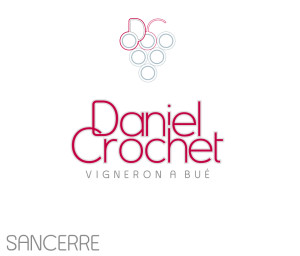
Location: The plots are located in the towns of Sancerre and Bué, all AOC Sancerre.
Production Area: 0.8 hectares
Soil: 2 main types of soil: terres blanches (clay-limestone), and Kimmeridgian marl
Average Age of the Vines: 30-33 years old
Grape Varieties: 100% Pinot Noir
Growing Method: Simple Guyot and Cordon de Royat
Harvest: The grapes are handpicked, then sorted and transported to the press by conveyor belt.
Vinification: The pink color is obtained by sequential pneumatic pressing of the whole Pinot Noir grape bunches. Static settling for about 48 hours is carried out at low temperatures. Fermentation takes place in tank at temperatures between 18-22°C.
Aging: On the fine lies for 3-4 months. Light fining and plate filtration, followed by tartaric stabilization. Bottling on the property.
Tasting Notes: Brilliant pale salmon color. The bouquet is fragrant with aromas of ripe strawberries and raspberries. Beautifully fresh on the palate and perfectly balanced.
Food Pairings: Pairs well with salads, asian cuisine, chicken dishes, etc.
Serving Temperature: 10°C when served as an aperitif, and 12°C when served with a meal.
Sancerre Rouge
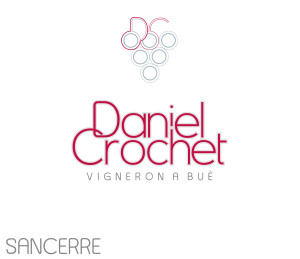
Terroir: The terroir is composed of two main types of soil: terres blanches (clay-limestone), and Kimmeridgian marl
Production Area: 2 hectares
Grape Variety: 100% Pinot Noir
Average Age of the Vines: 17-43 years old
Growing Method: Guyot simple or Cordon de Royat
Viticulture: The vineyard has been in conversion to certified organic agriculture since 2020.
Harvest: The harvest is hand-picked, sorted, and bunched (total or partial depending on the vintage) before being put in the tank.
Vinification: Cold maceration for 6-14 days, then fermentation with the use of indigenous yeasts at a temperature of 16-26°C. Pumping over and light punching down during this period. The vatting lasts for a period of 18-30 days. The press juices are incorporated into the free-run juices, or they are vinified separately. 60% of the juices are put directly into barrels and 500 liter barrels, 40% in wooden vats in order to carry out the malolactic fermentation.
Aging: Maturation in barrels for about 12 months, then placed in concrete tanks for a period of 4-6 months. Bottling on the estate.
Tasting Notes: Vibrant, purplish red color. The nose expresses seductive notes of red berries, such as raspberry and sour cherry. Beautiful structure on the palate.
Food Pairings: Pairs well with beef, veal, and mutton dishes.
Serving Temperature: 12-14°C
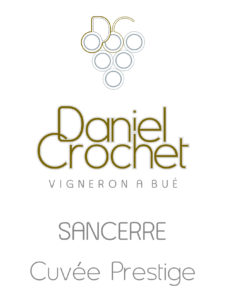
Sancerre Rouge Cuvée Prestige
Location: Situated in the towns of Sancerre and Bué, all AOC Sancerre.
Production Area: 0.4 hectares
Age of Vines: 41-47 years old
Soil: Clay-limestone, Kimmeridgian marl
Grape Varieties: 100% Pinot Noir
Training System: Guyot simple or Cordon de Royat
Harvest: Manually done, sorted and destemmed (completely or partially, depending on the vintage). This cuvee is produced from old vines.
Vinification: Cold maceration for 5-8 days, then the fermentations begin at a temperature of 22-26°C, using indigenous yeasts. Light remontage and pigéage take place during this time. Fermentation lasts for 18-30 days. The press juice is vinified separately, then blended with the free-run juice, after which it is placed in barrels (new wood every 3 vintages)and 500-liter casks to encourage malolactic fermentation. Aging lasts about 12 months. The wine is then transferred into concrete tanks for 4-6 months. Bottling on premise.
Tasting Notes: Deep red color with shades of violet. The nose is complex and precise, offering aromas of ripened blueberries and blackberries. On the palate, this wine is powerful, with ripe tannins. The fruity aromas are reflected on the palate, combined with a lovely woody note.
Serving Temperature: 12-14°C, either enjoyed on its own or accompanying a meal
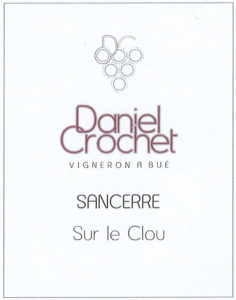
Sancerre Rouge Sur Le Clou
Production Area: 0.15 hectares
Soil: Marl sediments dating from the Jurassic period, locally called “Marnes de Saint-Doulchard”. Subsoil of limestone.
Grape Variety: 100% Pinot Noir
Average Age of the Vines: 45 years old
Viticulture: The vineyard has been certified organic since 2023.
Pruning Method: Guyot simple.
Harvest: Manually done. The grapes are sorted then vatted in whole bunches.
Vinification: No added sulfites. Cold maceration for 6-10 days before fermentation starts. Only indigenous yeasts are used. No remontage or pigeage, only infusion. Vatting period lasts 18-30 days. The “jus de presse” is incorporated into the “jus de goutte”. The juice blend is placed directly into barrels that have been used 3-5 times and malolactic fermentation proceeds.
Aging: About 12 months in barrels. Restocking in vats for 4 to 6 months. No fining, filtration, or tartaric stabilization. Bottling on the estate.
Tasting Notes: Complex nose of floral, spiced, and intense red fruit notes. Crisp and fresh yet lingering on the palate.
Food Pairings: Goes well with duck or other wild fowl.
Serving Temperature: 12-14°C
Domaine de Juchepie (Biodynamic)
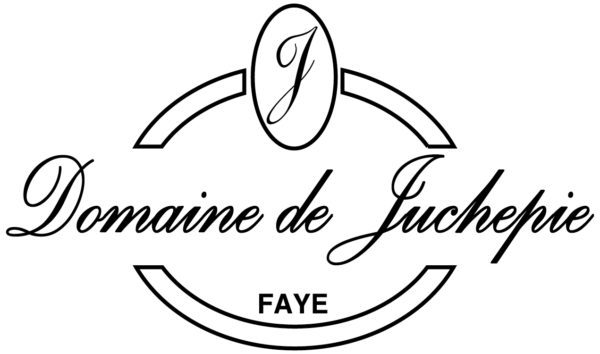
The Estate
In 1985, Eddy Oosterlinck (Belgian by birth) and his wife Mileine moved to Coteaux du Layon to follow their passion of making natural Chenin Blanc. 7 hectares of 50+ year old Chenin Blanc vines (with the oldest planted in 1911) are planted on topsoils of clay and slate with a slate subsoil which create wines of intense minerality and complexity. The proximity to local rivers, augmented by the occurrence of morning mist or rain, stimulates the development of botrytis at Juchepie. Vintages rich in botrytis allow Eddy to make his beloved sweet cuvees. When there is less noble rot in the vineyard, sweet wine production continues, just with more passes through the vineyard, and the production of the dry whites naturally increases. The balance of dry to sweet wine produced here is thus determined by nature.
Juchepie is certified organic by Ecocert and also certified biodynamic by Biodyvin. Yields are controlled by pruning down the number of buds (6-10 per plant, depending on the age) rather than green harvesting. The vines are nearly all Chenin Blanc with a small bit of Cabernet Franc. The fruit is harvested in 4-8 passes, pressed early in the evening, starting very gently, giving just enough force to burst a few berries and allow the juice to trickle down through the pressed fruit. As the trickle of juice slows to a drip, Eddy turns up the pressure to encourage a greater flow, and in a process that takes perhaps 24 hours he gently teases about 85% of the juice from the grapes. Once extracted, the juice from each individual pressing is combined. The juice then goes into barrels, new wood for the best sweet wines and older for the other cuvees; there is minimal intervention after this point.
The cellar is humidified with a sprinkler hosepipe buried in the gravel, a necessary intervention as the impermeable concrete floor keeps the air in the cellar very dry. Eddy turns this on whenever he enters, sometimes allowing it to run for half the day in times of warmth and drought when the ambient humidity is very low. It also has the effect of modulating the temperature, which never rises above 18ºC. Otherwise there are no additions to the wine – no yeasts, no enzymes, and certainly no sugar, just a little sulphur before the wines go into bottle, and minimal racking along the way.
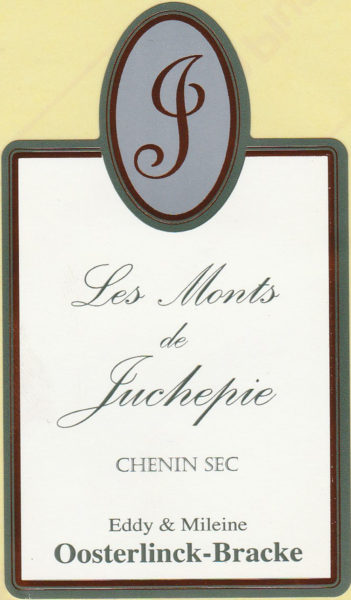
Les Monts De Juchepie Chenin Sec
Production Area: 7 hectares
Soil: Sandstone shales, spilite, rhyolite, phtanite
Average Age of the Vines: 50+ years old
Average Yield: 30 hl/ha
Grape Varieties: 100% Chenin Blanc
Viticulture: Biodynamic farming
Harvest: Manually done. Several consecutive pickings, selecting only the golden ripe grapes without any botrytis.
Vinification: The grapes are pressed manually in a vertical presser. No added yeasts or chaptalization.
Aging: 11 months in oak barrels plus one month in tank.
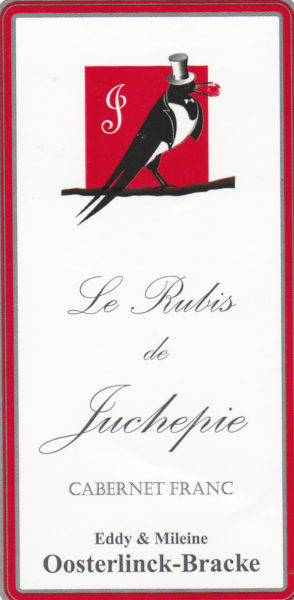
Le Rubis De Juchepie Cabernet Franc
Grape Varieties: Cabernet Franc
Average Yield: 20 hl/ha
Alcohol: 12.5%
Viticulture: Biodynamic farming
Harvest: Produced from old vine Cabernet Franc grapes, handpicked in small cases.
Vinification: Destalked by hand, vertically pressed after 3-4 weeks of maceration
Aging: Amphora fermentation for 12 months
Bottles Produced: 3,300 bottles

L'Amphore De Juchepie Pineau d'Aunis
Grape Varieties: 100% Pineau D’Aunis (Chenin Noir)
Average Yield: 30 hl/ha
Alcohol: 14%
Viticulture: Biodynamic farming
Harvest: Produced from Pineau d’Aunis grapes, also called Chenin Noir. Handpicked in small cases.
Vinification: Picked and destalked by hand; vertically pressed after 4 weeks of maceration
Aging: Amphora fermentation for 12 months
Bottles Produced: 1,420
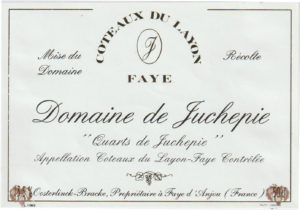
Coteaux du Layon Faye Quarts De Juchepie Cuvée Emiel
Name: 1993 was the year that Eddy Oosterlinck’s father Emiel passed away, and so this cuvée was named in his honor.
Appellation: Coteaux du Layon Faye
Soil: Composed of green and purple slate and spilite (volcanic rock)
Style: Sweet white wine
Grape Variety: Chenin Blanc
Viticulture: Biodynamic farming
Harvest: Manually done
Vinification: The grapes are pressed manually in a vertical presser. Fermented in oak barrels without any added yeasts or sugars.
Bottling: After 12-18 months of barrel aging.
Average Yield: 10-15 hl/ha
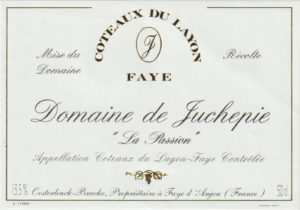
La Passion de Juchepie Coteaux du Layon Faye
Overview: La Passion is produced from a selection of very concentrated grapes. Depending on the vintage, these may be very botrytized or not. If not, then the grapes go through the process of passerillage where they are air-dried and shriveled after harvest in order to increase their concentration of sugars.
Appellation: Coteaux du Layon Faye
Soil: Purple shales, sandstone shales, spilite, rhyolite, phtanite
Style: Sweet white wine
Grape Variety: Chenin Blanc
Viticulture: Biodynamic farming
Harvest: Manually done
Vinification: The grapes are pressed manually in a vertical presser. Fermented in oak barrels without any added yeasts or sugars.
Aging: 18-24 months in oak barrels.
Average Yield: 5-10 hl/ha
Domaine de La Pagerie
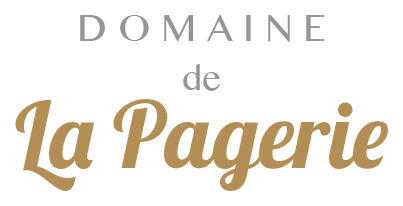
The Estate
After the acquisition of Domaine Guy Malbète in 2017, our soils are made of clay limestone, sandy loam and siliceous pebbles and, for our most elevated grapevines, sandy gravel. The winery now spans 10 hectares of grapevines, the oldest of which were planted by Domaine Malbète in 1970.
Following in the footsteps of our predecessor Guy Malbète, we work our soil to ensure our grapes feature the best aspects of our terroir. But we have also added our own touch, using only organic fertilizers in order to protect the organisms living in our soils. The use of mating disruption techniques avoids the need for insecticides. Lastly, we only protect our vineyard against diseases when necessary so that our grapes can end their growing cycles at optimal maturity.
The Reuilly wine region extends over nearly 270 hectares in the Indre and Cher Departments.
Planted on gently sloping hillsides, the grapevines flourish in marly limestone soils, overlooked by terraces of sand and gravel which receive plenty of sunshine. That exposure along the banks of the Arnon and the Cher releases the full expressiveness of nicely matured wines.
As the Berry’s emblematic wine region, Reuilly has long sustained deep roots in the history of Centre-Loire wines. Legend has it that, in the 7th century, King Dagobert donated his fields, grapevines and meadows in the region to the monks of the Royal Abbey of Saint-Denis outside Paris.
Reuilly shares its use of Sauvignon and Pinot Noir grapes with the other AOCs in its winemaking region: Quincy, Menetou-Salon, Sancerre and Pouilly-Fumé.

Reuilly Rouge
Grape Variety: 100% Pinot Noir
Viticulture: Sustainable cultivation.
Vinification: Fermentation occurs in stainless steel vats with frequent punching down.
Aging: In stainless steel vats.
Tasting Notes: A touch of dark red enhances its ruby hue. Red berries are preponderant in the nose.
Food Pairings: Red meat, wild game, aged cheeses.
Serving Temperature: 15° – 17°C

Reuilly Blanc
Grape Variety: 100% Sauvignon
Food Pairings: Oysters, Filet of sole, white meats, goat cheese; ideal as an aperitif.
Serving temperature: 8° – 10°C
Cellaring potential: 2023-2027
Viticulture: Sustainable cultivation.
Vinification: Temperature-controlled fermentation in stainless steel vats; use of selected yeasts. Aged on lees in in stainless steel vats; light filtration.
Soil: Clay-limestone; Siliceous soils (sand, gravel, etc.)
Color: Straw-gold
Tasting notes: Minerality dominates the nose; mouthfeel is nicely fresh with a long finish.

Reuilly Les Terres De Silice Rosé
Grape Variety: 100% Pinot Gris
Soil: Calcareous-clay, silty sand, siliceous pebbles and sandy gravel.
Viticulture: In organic conversion since 2021.
Average Age of the Vines: 20-30 years old
Vinification: This wine is made in a similar fashion to the white wine. Light maceration in the wine press. Settling for 48 hours and fermentation in tank at 17°C.
Aging: 6 months in stainless steel tank.
Tasting Notes: Salmon pink color. Aromas of apricot and orange blossom on the nose which are reflected on the palate. Soft and round at the start with a well-chiseled, fresh finish.
Food Pairings: This wine is perfect as an aperitif, or when paired with spicier cuisines.
Domaine Estelle et Rodolphe Cognard (Certified Organic) – Touraine
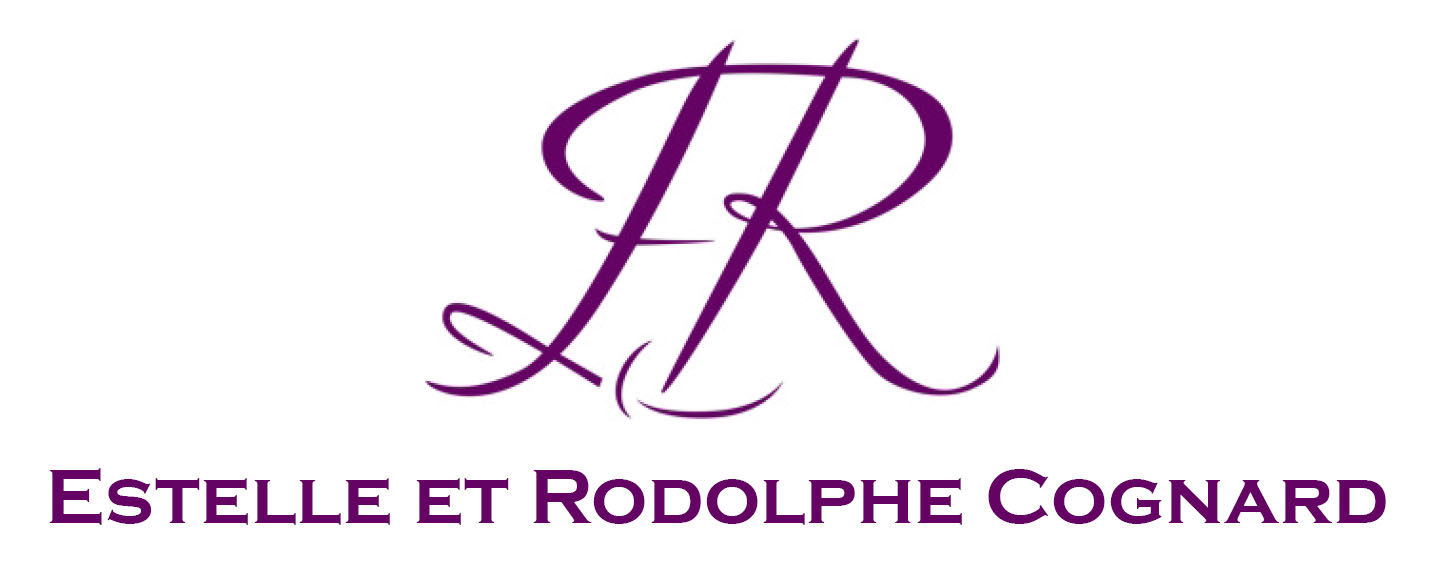
The Estate
1974 was a good year for Lydie Taluau with Max Cognard. It was that year that Lydie inherited 1 hectare of vines at the northwest end of Touraine and they established Domaine Lydie et Max Cognard. It was also the year that Lydie and Max’s daughter, Estelle, was born, followed by their son Rodolphe 4 years later.
In 1997, Estelle Cognard decided to gradually take over the family business, and in 2001 Rodolphe assumed winemaking duties, after which the estate was renamed Domaine Estelle et Rodolphe Cognard.
Today, the estate spans 15 hectares of vines in St Nicolas de Bourgueil and Bourgueil. Lydie and Max are now officially retired but are still very much a part of the business.
After a long battle with illness, Estelle’s brother Rodolphe sadly passed away on March 30, 2018. He transmitted his love of the profession, his talent in the cultivation of the vine, and the production of wines and thanks to his little notes during the various vinifications, the Cognard family continues to vinify, in his footsteps, fine and elegant red wines of the Loire Valley.
The Team
Estelle Cognard: Manager of the SCEA, in charge of all the commercial administrative part of the business as well as accounting and customer reception.
Olivier Nicolle: Vinification of the wines, manual work of the vine (pruning, green work, etc.), and management of the vineyard.
Matthieu Petit: Manual (pruning, green work, etc.) and mechanized (tillage, etc.) work on the vines, vineyard management.
Audrey Bossard: In charge of communications, work in the cellar (labeling, packaging, etc.), administration, commercial actions in the field (fair, etc.). Customer reception.
Lydie & Max Cognard: Since their retirement, Lydie has owned a cottage “le Berlot” in Benais. She now spends most of her time there. Max still takes care of the cellar for the filtration and helps from time to time in the vineyards.
The Terroir
11 ha of vines in A.O.P Saint-Nicolas de Bourgueil – The majority of these soils are made up of old alluvium. The sandy soils bring suppleness and elegance to the wine. 4 ha of vines in A.O.P Bourgueil – There are 3 types of soil here: majority clay-limestone, gravel, and sandy silt.
Viticulture
The vineyards are devoted in entirety to Cabernet Franc, planted at a density of 4,500 vines/ha, with the rows of vines interspersed with grass to keep down the weeds and to force the vines to root deeper for nourishment. Since the 1980s, the estate had practiced lutte raisonnée, or reasoned agriculture, but in 2017 they made the decision to covert to organic agriculture, and 2018 was their first organic vintage. In 2020, their domaine was officially certified organic.

Bourgueil Rouge Cuvée Les Tuffes
Soil: 2.5 hectares of clay-limestone, 1.5 hectares gravel
Production Area: 4 hectares in both Benais and Bourgueil
Average Age of the Vines: 25 years old
Varietal Blend: 100% Cabernet Franc
Harvest: Mechanical in order to split up the harvest depending on the maturity of the grapes
Vinification: Alcoholic fermentation lasts 14-21 days in stainless-steel thermo-regulated tanks. Pre-fermentation maceration for 48 hours at cold temperatures, followed by fermentation for about 18 days between 25-28°C to extract the aromas. Light filtration done with care.
Aging: A minimum of 18 months aging in tanks and partially in barrels followed by bottling.
Tasting Notes: Deep ruby color. The nose is complex with notes of stewed fruit and spices. The mouth is ample and well balanced, supported by the tannins and a lovely freshness.
Food Pairings: Grilled meats, poultry, goat cheese
Serving Temperature: 13-16°C
Cellaring Potential: Good to drink immediately, but especially 2 years after bottling. Cellaring potential of 2-10 years.

Saint-Nicolas de Bourgeuil Cuvée Estelle
Soil: Sandy soil, deep clay
Production Area: 8 hectares
Average Age of the Vines: 30 years old
Varietal Blend: 100% Cabernet Franc
Harvest: Mechanical in order to split up the harvest depending on the maturity of the grapes and the weather
Vinification: Fermentation lasts 7-18 days in stainless-steel thermos-regulated tanks. Pre-fermentation maceration for 48 hours at cold temperatures, then fermentation between 25-26°C to extract the aromas. Light filtration done with care.
Aging: Maturation between 8-14 months in stainless-steel tanks, followed by bottling.
Tasting Notes: Beautiful, limpid ruby color. The bouquet is fragrant with red fruit such as raspberry, blackcurrant, and strawberry. On the palate, the wine is fruity and easy to drink.
Food Pairings: Simple dishes, charcuterie, grilled meats, fish, goat cheese.
Serving Temperature: 12-15°C
Cellaring Potential: Good to drink immediately, but especially after 1-3 years

Saint-Nicolas de Bourgeuil Cuvée Les Malgagnes
Soil: Silty clay
Production Area: 2 hectares
Average Age of the Vines: 40 years old
Varietal Blend: 100% Cabernet Franc
Harvest: Mechanical in order to split up the harvest depending on the maturity of the grapes and the weather
Vinification: Alcoholic fermentation lasts 14-21 days in stainless-steel thermo-regulated tanks. 10% minimum of the vintage in barrels. Pre-fermentation maceration for 48 hours at cold temperatures, followed by fermentation for about 18 days between 30-35°C to extract the aromas. Light filtration done with care.
Aging: 15 months in tank and/or 10 months in Burgundian barrels for half of the maximum harvest, followed by bottling.
Tasting Notes: Dark brick color. The bouquet is complex with fragrant notes of wild berries. The palate is pulpy and concentrated. This is a wine of character that vividly expresses the terroir.
Food Pairings: For younger vintages, pair with poultry. For older vintages, pair with red meats and aged cheeses.
Serving Temperature: 15-17°C
Cellaring Potential: Good to drink immediately, but especially 2 years after bottling. Cellaring potential of 2-15 years.
2018 Reviews: “Richly textured with ripe tannins, the nose is red-fruited while juicy blackberry characters show through on the palate. Clean finish.” – 92pts, 2022 Decanter World Wine Awards
Awards: Silver Medal DECANTER World Wine Awards 2022
Domaine Florian Roblin (Organic)
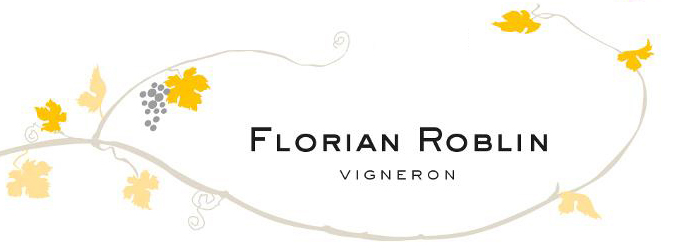
The Estate
The domaine was established in 2008 by Florian Roblin, the son and grandson of farmers. Florian developed a passion for wine and the vine by spending time with his grandfather, who cultivated a small vine on the plot of Champ Gibault. It was this spot where he would plant his vineyard in 2005. The first vintage was produced in 2008 (a tiny yield of 400 bottles), followed by more plantings in 2012 and the creation of his cellar. Today, the estate spans 4 hectares, of which 3 hectares are planted with Sauvignon Blanc, 0.80 hectares of Pinot Noir, and 0.20 hectares of Gamay. The estate has been certified organic since 2021.

Coteaux du Giennois Champ Gibault Blanc
Grape Variety: 100% Sauvignon Blanc
Appellation: Coteaux du Giennois
Soil: Clay soil with flint on a chalk subsoil.
Exposition: The vineyard faces south, southeast.
Viticulture: The vineyard has been certified organic since 2021. The soils have always been worked by hoeing and grassing. Short pruning and manual stripping.
Harvest: Manual
Vinification: In the cellar, the grapes are sorted on a table. Gentle pressing for the whites and long maceration for the reds. Vinification on fine lees in raw, concrete vats (Champ Gibault Blanc) and 225 liter barrels (Champ Gibault rouge).
Alcohol: 13.5 %
Residual Sugar: 0.5 g/L
Domaine Jean Teiller (Biodynamic)

The Estate
The Domaine Jean Tellier is a family business founded in the 1950s by Leon Millet. It found its true wine-growing vocation with Jean and Denise Tellier (Leon Millet’s daughter) who believed in the future of Menetou-Salon and worked to enhance their appellation’s reputation.
Annual production of the white, from Sauvignon Blanc, is in the region of 50,000 bottles, half of which is sold direct from the cellar door. The family also produces fine Menetou Salon rosé and red wine from pure Pinot Noir. Jean-Jacques and his wife Monique are now ably assisted by their daughter and son-in-law Patricia and Olivier who met in Beaune where Patricia was studying oenology.
The Domaine covers an area of 17 hectares and is located on the best slopes of the communes of Menetou-Salon, Parassy, Aubinges, and Vignoux sous les Aix:
- 10 hectares planted with Sauvignon the sole Menetou-Salon Blanc grape
- 7 hectares planted with Pinot Noir, the sole Menetou-Salon Rouge and Rose grape
- The average age of the vines is greater than 20 years
The Domaine has been a member of “Vignerons Indépendants de France” since 1995. Certified organic since 2017 and biodynamic since 2019.

Menetou-Salon Blanc
Production Area: 9 hectares of which 3.5 hectares are planted with vines over 20 years old
Grape Varieties: 100% Sauvignon Blanc
Soil: Mostly shallow clay limestone soil
Location: Situated on the side of the slopes located in the communes of Menetou-Salon, Parassy, Vignoux-sous-les-Aix, and Aubinges
Harvest: Harvested manually at optimum maturity at the beginning of September.
Vinification: De-stemming; the press is filled by conveyor belt. Pneumatic pressing is slow and gentle to limit the extraction of plant compounds. Cold, static racking. Fermentation in thermo-regulated vats for 8-10 weeks.
Aging: 95% in tank, 5% in barrel. Filtration employed. Estate bottled in March.
Tasting Notes: Golden color with green reflections. Powerful, rich nose, with notes of citrus, peach, and white flowers. When shaken, the nose reveals even more of its aromatic power and complexity. The attack is crisp and full-bodied. The acidity ensures that there is a good balance and the notes of white flowers enhance the fruity aromas on the nose. Lingers well, remains on the palette.
Food Pairings: The Menetou-Salon Blanc is the perfect accompaniment to fish, shellfish, white meat, poultry, chèvre…or simply as an aperitif.
Serving Temperature: Drink around 12°C
Cellaring Potential: Keep 3-5 years

Menetou-Salon Rouge
Production Area: 5 ha including the Clos des Treilles (2 ha) planted in 1965
Grape Varieties: Pinot Noir
Soil: Deep soil of clay-limestone
Location: Hillsides situated in the municipalities of Menetou-Salon, Parassy, Aubinges, and Vignoux- sous-les-Aix
Harvest: Manually done at the end of September/early October
Vinification: Rigorous sorting, separation of the grapes from the stalks. Cold pre-fermentation maceration for 4-6 days. Pumping over, several punch downs, and delestage (gentle extraction of phenolic compounds by oxygenating the juice). Alcoholic fermentation using indigenous yeasts and maceration for 15-20 days. Devatting without pumping. Malolactic fermentation without seeding.
Aging: 6 months minimum (95% tank, 5% barrel) in order to preserve the finesse and aromas of the Pinot Noir. Bottles on premise.
Tasting Notes: Brilliant, cherry-red color. The bouquet is rich with juicy, berry notes like strawberry, blackberry, and morello cherry, complemented by a subtle spice. On the palate, it is supple and fleshy with notes of cassis and red fruits. Well-balanced structure, refined tannins, and good persistence.
Food Pairings: Roasted or grilled meats, richer fish, and aged cheeses.
Serving Temperature: 16°C
Cellaring: 3-5 years

Menetou-Salon Rosé
Location: Hillsides located within the communes of Menetou-Salon and Aubinges
Production Area: 1 hectare
Soil: Deep layers of clay & limestone
Grape Varieties: Pinot Noir
Harvest: At optimal maturity at the end of September, early October.
Vinification: Destemming, followed by a slow, gentle, pneumatic pressing. Static settling in cold temperatures. Thermo-regulated fermentation for 3-4 weeks.
Aging: Aged in tanks for 4-5 months. Bottled on premise.
Tasting Notes: Salmon pink color. The bouquet is very fruity with notes of citrus, peach, and strawberry. Supple and fresh when it first touches the palate, dominated by notes of blackcurrant and strawberry. Beautiful balance between sweetness and acidity with good length on the finish.
Food Pairings: Perfect as an aperitif or paired with grilled fish/meat and Asian cuisine.
Serving Temperature: 11 °C
Cellaring: 2 years
Menetou-Salon Mademoiselle T
 Location: 1.5 hectares from the “Berton-Moreau” parcel comprising vines planted in 1984
Location: 1.5 hectares from the “Berton-Moreau” parcel comprising vines planted in 1984
Grape Varietals: 100% Sauvignon Blanc
Soil: Argilo-Calcareous which is very stony
Vinification: Grapes harvested at the moment of optimal maturity towards the end of September/beginning of October. The stalks are removed and the press filled using a rolling belt. The pressing process is pneumatic, carried out slowly and gently. The settling process takes place statically and at a low temperature.
The fermentation process is carried out in temperature controlled tanks for 6 to 8 weeks. The wine is aged in stainless steel vats over fine lees and stirred periodically. Bottled by us in our cellars beginning in the month of March following the year of harvest.
Tasting notes: Gleaming, limpid golden-yellow colour. The bouquet is one of minerality revealing, when swirled, notes of citrus and white flowers. The initial taste is crisp and full in the mouth – aromatic, deep and intense – a blend of finesse, elegance and great persistence of taste. Mademoiselle T may be enjoyed as an aperitif, with fish and scallops, white meats and even foie gras (after the wine has been cellared for several years).
Serving temperature: around 12°C
Domaine Les Maisons Rouges (Biodynamic)
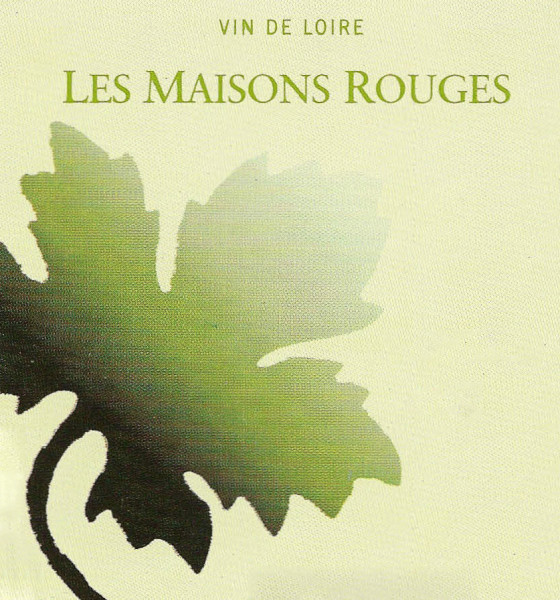
The Estate
Domaine Les Maisons Rouges was established in 1994 among the vineyards of Jasnières in the Loire Valley. This terroir was chosen for its great potential; its high quality soils, native grape varietals, and accessible land presented rich possibilities to Benoit and Elisabeth Jardin. Initially encompassing a mere half hectare of red grape vines, the estate has now been expanded to 10 hectares of which 2 are planted with red grape vines and 5 with white. This change took place with some difficulty, as the vineyards (composed of a great quantity of very old vines) had to be returned to a healthy, productive state.
When Les Maisons Rouge first began over 15 years ago, it was planted with several red grape varietals, including Pineau d’Aunis, Gamay, and Cabernet Franc. Today, the domaine exclusively grows l’Aunis for its red wines and Chenin for the whites.
In 2002, the Jardins made the choice to practice organic agriculture for which they were certified in 2007. At the same time, they began aging on the lees in oak barrels in order to obtain more complex wines with good structure and longer cellaring potential. The goal of this aging method is to produce wines that favor the minerality of the terroir over the fruitiness of the grapes.
In 2009, the domaine became certified biodynamic under the Biodyvin label to reaffirm their commitment to viticulture that is respectful to the environment. This method results in healthy grapes, allowing the winemakers to produce wines without the use of sulfur (except during unfavorable years and bottling).
The majority of the plots are spread out over the southern-facing, very well-exposed slopes of Jasnières in the town of Lhomme, or to the east in the Coteaux du Loir within the town of Ruillé sur Loir.Location
The Vines
Chenin Blanc, or Pineau de Loire, is the exclusive varietal for the AOC Jasnières and Coteaux du Loir blanc. It is the historic grape of the Loire, present from Anjou to Touraine over the majority of the AOC.
As for the red vines, they are planted exclusively with Pineau d’Aunis, another ancient varietal of the Loire Valley. It is a parent of the Chenin grape whose origin dates make to the middle ages. Its name comes from a selection made in that period to the Piory of Aunis in the town of Dampierre, near Saumur in le Maine and Loir. Also called Chenin Noir, its organoleptic characteristics are close to that of its illustrious cousin-it has aromatic richness, finesse, and spicy, peppery notes.
The vines are planted in rows about 1.5-1.7 meters between them. All of the old vines are rehabilitated and planted with vines from the plot, all while respecting the genetic diversity. This choice of mass selection is now applied to all new plantings.
The vines are cultivated with respect for the terroir. The goal of the winemakers is to bring the soil alive and to foster maximum rooting of the vines to reach the deeper geological layers which results in wines that fully express the unique characteristics of this land.
Vinification
The winemakers apply the same natural methods to vinification as they do to viticulture. No yeast or oenological product is added, and nothing is removed. A minimal dose of sulfur is introduced only after the fermentation process or during bottling in order to protect the wines. Vinification is done by plot for the whites and by the age of the vines for the Coteaux du Loir rouge.
The grapes are harvested manually into cases at the beginning of October in order to give the grapes time to reach optimum maturity for the favorable vintages. This is followed by sorting which divides the harvest (by plot) into bunches reserved for the dry to the sweeter whites.
The white Jasnières and Coteaux du Loir wines are produced from the Chenin grape varietal; they are more often than not dry without residual sugar, however certain vintages such as 2003, 2005, and 2009 produced exceptional sweet wines.
The white wines are aged sur lies for a period of 12-18 months in oak barrels that have aged 2-3 prior vintages. This aging in noble wood (no new wood) gives the wine complex and subtle aromas, as well as the potential for aging long term.
The red Coteaux du Loir wines have a spicy quality that is unique to the Pineau d’Aunis grape varietal. They combine notes of pepper and red fruit and have a powerful structure, thanks to the age of the vines from which they are produced. In fact, this structure is in particular enhanced by the use of cold fermentation and pigeage which allows a gentle extraction of the constituents of the grape (anthocyanins, tannins, aromatic compounds, etc.). The Pineau d’Aunis is the sole grape used for the reds-no blending with other grape varietals is performed. The youngest vines are 14-50 years old and are used for the Garance cuvée, whereas the older vines are used for the Alizari cuvée.
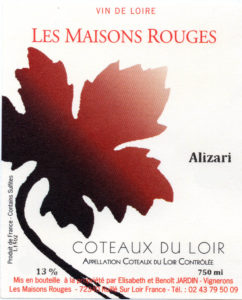
Coteaux du Loir Rouge Alizari
Name Origin: “Alizari” or “madder root” is a plant root from which a red pigment or dye is produced. “Alizari” is a reference to the vibrant red color of this wine.
Location: Different parcels on the communes of Ruillé sur Loir and Marçon, with the same soil.
Soil: Sandy-clay loam heavily loaded with flint and quartz on a bedrock of clay with perrons.
Grape Varieties: 100% Pineau d’Aunis
Average Age of the Vines: 50 to more than 100 years old
Harvest: Manual
Vinification: Maceration by punching down; fermentation in barrels. Clarification by racking no filtration. Vinified without sulfur until bottled.
Aging: In barrels for 14 months sur lies.
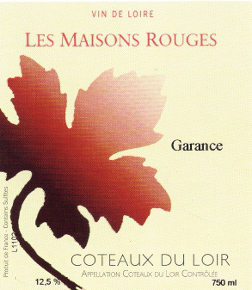
Coteaux du Loir Rouge Garance
Name Origin: “Garance” is the powdered form of the Alizari or madden root which produces a red dye or pigment–a reference to the vibrant red color of this wine.
Location: Different parcels on the communes of Ruillé sur Loir and Marçon, with the same soil.
Soil: Sandy-clay loam heavily loaded with flint and quartz on a bedrock of clay with perrons, or flint nodules.
Grape Varieties: 100% Pineau d’Aunis
Average Age of the Vines: 10-50 years old
Vine Management: “Taille courte en double cordons” for the younger vines, and “gobelets aplatis” for the older vines.
Harvest: Manual
Vinification: Maceration by punching down; fermentation in barrels. Clarification by racking no filtration. Vinified without sulfur until bottled.
Aging: In barrels for 12 months sur lies.
Tasting Notes: Light in color which suggests a delicate wine, however the surprisingly intense bouquet leaps from the glass with aromas of fruit, pepper, and flowers. On the palate, this wine is powerful yet elegant with notes of cherry, raspberry, and pepper.
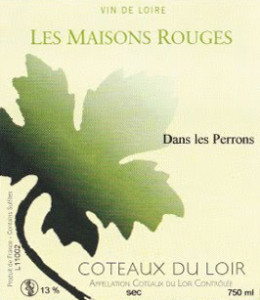
Coteaux du Loir Sec Dans les Perrons
Location: This cuvée is produced from the fruit of 4 different plots: “La Fontenelle”, “La Bosserie”, “l’Etre Pucelle” et “Les Blettes”. These parcels are situated at the top of the slope and have identical soils rich in “perrons”, or masses of flint rock.
Soil: This terroir from the Eocene (tertiary era) is based on a bedrock of “perrons” or flint nodules and clay. The soil is composed of sandy loam with 80-90% flint and quartz on the surface and 40% on average in the subsoil. This excessively stony terroir combined with drying ventilation is ideal for the Coteaux du Loir white wines harvested from young vines.
Average Age of the Vines: 8 to 15 years old
Grape Varieties: 100% Chenin Blanc
Alcohol Content: 12.5-13%
Harvest: Harvested manually in mid-October into boxes.
Vinification: Fermentation and aging takes place in oak barrels for 13 months. The winemakers use indigenous yeasts, and use no added sulfites when bottling. This wine is unfiltered.
Tasting Notes: Very fresh and pleasant to drink; blossom and peach aromas dominate, complemented by a distinct minerality and fresh woodsy notes. This wine is round and creamy on the palate.
Food Pairings: Goes well with aromatic dishes such as risotto, or desserts made with exotic fruit.
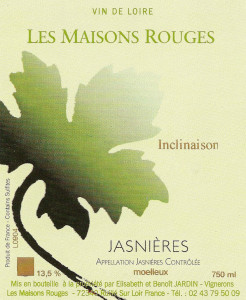
Jasnières Moelleux Inclinaison
Location: The “Clos des Jasnières” is at the heart of the Jasnières appellation. The vines are located on the upper part of the slope. The name of this cuvée, “Inclinaison”, meaning “incline”, is a reference to the elevation of the grape vines.
Average Age of the Vines: Over 70 years old
Soil: The soil is a cénonien (Mesozoic) combination composed of clay, sand, and green mica with 80% flint and spongolithes on the surface and 20% beneath the earth. This deep clay soil rich in flint gives the Clos des Jasnières the power and minerality which is characteristic of the great Jasnières wines.
Grape Varieties: 100% Chenin Blanc
Residual Sugar: 41 grams
Alcohol Content: 13.5%
Harvest: Harvested manually in mid-October into boxes when the grapes are overripe.
Vinification: Fermentation and aging in oak barrels for 14-24 months. Vinification without yeast or added product, sulfites only added at bottling. This wine is unfiltered.
Tasting Notes: Yellow gold in color. Semi-dry to sweet wine. Rich, sweet bouquet with hints of honey, coconut, and acacia. Open and expressive on the palate. Firm, mineral, and stony with a firm finish.
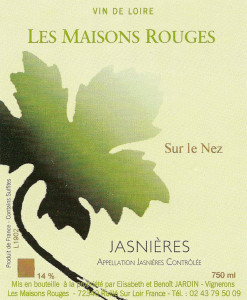
Jasnières Sec Sur le Nez
Location: The grapes used to produce this wine come from 2 different parcels: “Clos des Jasnières” and “La Gidonière.” The vines on these plots were planted between 1900 and 1935 and are situated on the highest part of the slope, above the nose, or “nez” of the tuffeau rock formation.
Soil: This terroir is composed of multiple layers, including limestone, or tuffeau, white and pink clay, green sand, and mica, with with 80% flint and spongolite on the surface and 20-40% in the subsoil. This terroir of deep clay over limestone gives this cuvée all the power and minerality of the greatest Jasnières.
Average Age of the Vines: Over 70 years old
Varietal Composition: 100% Chenin Blanc
Harvest: Harvested manually in mid-October into boxes
Average Yield: 33 hl/ha
Vinification: Fermentation and aging in oak barrels for 14 months. Vinification without yeast or added product, sulfites only added at bottling. This wine is unfiltered.
Tasting Notes: Dry wine, without residual sugar. The nose is very open with an amazing cocktail of floral (acacia) and fruity notes (white fruits, citrus), and a pleasant minerality. Sharp attack. On the palate, an explosion of flavors is complemented by a roundness and balance. Beautiful harmony & finesse with a long, lingering finish.
Food Pairings: Serve with curried chicken and goat cheese.
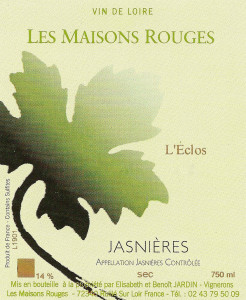
Jasnières Sec L'Éclos
Location: This cuvée is produced from 2 plots in Clos des Molières: Clos des Barrières and Blettes. These plots in the municipality of Lhomme represent the western part of the Jasnières appellation. The vines are located in the lower part of the slope.
Soil: The soil is composed of varied strata of clay & limestone, loaded with flint and spongolites.
Average Age of the Vines: 20-35 years old
Grape Varieties: 100% Chenin Blanc
Vinification: Manually harvested mid-October into cases. Fermentation and aging in oak barrels for 14 months. Vinification is done using indigenous yeast with no added sulfites prior to bottling. This wine is unfiltered.
Tasting Notes: The color is a clear, bright yellow gold with hints of green. The nose is intense and complex with aromas of citrus, spice, white fruit, and honey. On the palate, the attack is voluptuous, followed by a nice freshness, giving structure to the wine. Nice minerality and great length.
Food Pairings: Pairs beautifully with fish
Serving Temperature: 12°C
Cellaring Potential: Can be drunk immediately or kept for 5-8 years
Domaine Raimbault-Pineau
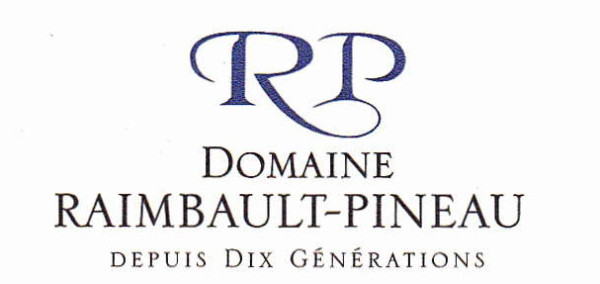
The Estate
Located in the heart of the village of Sury-en-Vaux (5 km from Sancerre), Domaine Raimbault-Pineau was formed by a family of Sancerre winemakers that have been producing wine for over 3 centuries.
In 1946, Lucien Raimbault acquired a well-known vineyard; its terroir was composed of chalky-clay and enjoyed extraordinary sun exposure. The Raimbault family has continuously worked this land, and today the domaine has 40 separate plots of AOC Sancerre vines, all located around the village of Sury-en-Vaux (La Montée de St. Romble, La Côte de la Pointe, La Côte de Sury).
The domaine also makes Pouilly-Fumé, “La Montée des Lumeaux” (acquired 10 years ago), situated in the village of St. Martin-sur-Nohain, as well as Coteaux du Giennois, “Les Vignes du Dimanche,” in the village of St. Père. All of the vineyards are worked in the traditional manner, with great care and attention paid to the vines.

Coteaux du Giennois
Terroir: The vineyard is situated on the slopes of the Loire Valley and benefits from a clay-siliceous soil on the surface and a dry, limestone subsoil.
Fermentation: Fermented at low temperatures (14°-16°C) in thermo-regulated stainless steel tanks
Vinification: Bonding with bentonite, traditional methods are used alongside modern techniques
Aging: The wine is matured on its fine lies right up until bottling
Grape Varieties: 100% Sauvignon Blanc
Tasting Notes: The Coteaux du Giennois Blanc is rich and aromatic and combines the sweetness of the fruit with a lovely minerality.
Serving Temperature: Best when served chilled, at about 10-12°C
Cellaring Potential: 2-3 years
Food Pairings: Very pleasant and refreshing, this wine is excellent as an aperitif, with oysters and other shellfish

Coteaux du Giennois Rosé
Overview: First produced in 1991, this wine expresses its potential on a clay-siliceous soil with a limestone sub stratum.
Grape Varieties: 80% Pinot Noir, 20% Gamay
Terroir: Limestone soils – siliceous clay
Vinification: Fermentation in stainless steel tanks at low temperatures from 12 to 16 °C. Aging on fine lees.
Tasting Notes: The nose is fragrant with ripe citrus, red fruits, wild flowers, and light spice. On the palate, juicy, lingering berries and zesty tangerine.
Food Pairings: Apéritifs – Charcuterie – barbecued meats.
Cellaring Potential: 2-3 years depending on the vintage. Serve at 8-10°C.

Pouilly-Fumé
Overview: The Pouilly-Fumé is a dry, fruity wine produced from Sauvignon grapes.
The Soil: Soft, chalky clay
Harvest: Harvesting is done at the end of September when the grapes have obtained their optimum ripeness.
Vinification: The grapes are taken directly to the pneumatic press where the must is extracted with great care. After racking, the must in then transferred to the thermo-regulated tanks where it is fermented for 1 month at a constant temperature of 16-18°C (61-64°F). This long, slow fermentation conserves the wine’s unique aromas, and after resting on fine lees for 5-6 months, each cuvée is blended with great care to ensure the highest possible quality.
Filtration & Bottling: Following a light filtration, the first bottling begins at the end of March. Here the modern bottling assembly utilizes the latest sanitary equipment and techniques in order to maintain the highest standards of cleanliness.
Serving Temperature: Best when served young and chilled, about 10°C
Tasting Notes: This is a fine, complex wine with notes of mineral, citrus, quince, and honey.
Food Pairings: Ideal as an aperitif, this wine also pairs well with starters, seafood, and foie gras.

Pouilly-Fumé Les Lumeaux
Overview: These vines are the oldest of the domaine and are planted on an exceptional 2.5 hectare plot specifically chosen for this wine which is fruity and elegant, with great longevity.
Grape Varieties: 100% Sauvignon Blanc
Terroir: Caillotes (calcareous pebbly soils) and limestone
Vinification: Fermentation at low temperatures in stainless steel tanks. Maturation on fine lees.
Tasting Notes: An elegant, powerful, fresh, and well-balanced wine.
Food Pairings: Grilled fish, shellfish, meats, BBQ, and sushi.
Cellaring Potential: 5-10 years depending on the vintage. To be served at 12-14 °C.

Sancerre Blanc
Overview: The Sancerre Blanc from Domaine Raimbault Pineau is a very dry, white wine produced from Sauvignon grapes.
The Soil: The vines are planted on 2 types of soil–soft, chalky clay and pebbly limestone.
Harvest: The grapes are harvested once they have reached their optimal maturity
Vinification: The grapes are quickly transported to the pneumatic press where the extraction of the must is done slowly and smoothly. The juice is then put into thermo-regulated tanks where the temperature is monitored and controlled carefully so that it remains low (14-16°C). Very long and very smooth, this type of fermentation preserves the maximum amount of aromas of the juice.
Aging: After a maturation period on its fine lies, each vintage is blended with precision in order to obtain consistently excellent wines.
Tasting Notes: This fine Sancerre is brisk with plenty of fruit in the bouquet and on the palate, as well as vegetal notes of cassis leaf, white flowers, and citrus. The attack is frank, and the mouth feel is rich and round.
Food Pairings: Ideal as an aperitif. Pairs well with starters, seafood, and goat cheese.

Sancerre Rosé
Overview: The Sancerre Rosé is a very fruity, yet subtle and complex wine composed of Pinot Noir grapes.
Soil: The vines are planted on 2 types of soil–limestone and rocky limestone.
Grape Varieties: Pinot Noir
Harvest & Vinification: The grapes are harvested once they have reached their optimal maturity, then are quickly transported to the pneumatic press where the extraction of the must is done slowly and smoothly. The juice is then put into thermo-regulated tanks where the temperature is monitored and controlled carefully so that it remains low (14-16°C). Very long and very smooth, this type of fermentation preserves the maximum amount of aromas of the juice.
Tasting Notes: The Sancerre Rosé evokes autumnal fruit and reveals juicy aromas of strawberry and raspberry.
Serving Suggestion: Serve cool, at a temperature of about 12°C
Food Pairings: From morning snacks to summery appetizers and picnics, this wine is the perfect accompaniment to cold meats, pastries, and grilled meats.

Domaine Lucien Raimbault Menetou-Salon Blanc Les Chamblins
Overview: The Menetou-Salon Blanc comes from a single plot called “Les Chamblins” spanning 3.63 hectares and has been available since 2020 (1st harvest in 2019).
Soil: Siliceous clay
Grape Variety: Sauvignon Blanc
Tasting Notes: The Menetou-Salon Blanc is best consumed young. It has a pale yellow color and is very lively on the palate. It is a fine, floral, and fruity wine that is deliciously refreshing.
Vinification: Fermentation takes place at low temperatures between 12-16°C in stainless steel tanks and then is matured on fine lees.
Serving Suggestion: Serve between 10-12°C. Ideal as an aperitif, it pairs well with starters, shellfish, fish, cold meats, and goat cheese.
Cellaring: 3-5 years depending on the vintage.
Domaine Sauger
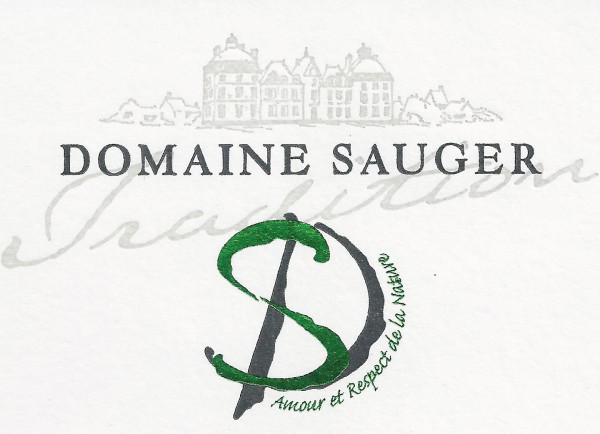
The Estate
Domaine Sauger has been family owned for 5 generations: From François-Sylvain, to Eugène, Lucien, Marcel, and now finally Philippe, the family has managed the winery since 1870.
In 1920, the grandfather Lucien operated 4 hectares of hybrid variety vines. The sale of the wine was done by a local négociant.
In 1958, Marcel, Philippe’s father, was forced to pull his hybrid vines due to phylloxera. Then in 1972, 4 hectares of vines were entirely replanted with noble varietals, such as Sauvignon.
In 1988, after receiving his BEPA in Viticulture-Oenology, and full of knowledge and experience after his internships in Gers and Sancerre, Philippe took the reins of the family estate and abandoned all other agriculture (asparagus, pickles ..) except for grapes, after which the domaine had 7 hectares to use for vineyards.
Philippe’s interest is focused exclusively on the vine, all while developing the vine nursery to the requirements of today. Modification of the production system and winemaking ensued: modernization of equipment, acquisition of a temperature controlled tank system … all this has led to a range of more rich and complex wines.
Today, Domaine Sauger is spread out over 30 hectares within the Appellation Contrôlée of Cheverny.
Location
Domaine Sauger is situated on the left bank of the Loire Valley, at the heart of Loir-et-Cher and the Chateaux of the Loire, such as Cheverny, Chambord, Blois, as well as Chenonceau. It is also bordered by La Sologne, a natural forest paradise.
Climate
Oceanic climate, tempered by the summer, and influenced by the grand forests of Sologne (national forests of Chambord, Cheverny, and Foret de Russy)
Soil
Sandy clay
Appellation
The Controlled Appellation of Cheverny is a relatively recent appellation; it was officially recognized by decree on March 26th, 1993.
It covers an area of 574 hectares within 24 districts situated in the Loire Valley, where about 40 winemakers produce nearly 27,000 hectoliters of wine per year.
Located between Loire and Sologne, the appellation of Cheverny is strongly marked by the movements of the Loire River, and the geology of the appellation is quite original compared to other appellations in the Valley: the soils there are predominantly of a sandy texture.
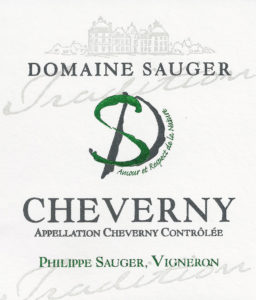
Cheverny Blanc Tradition
Grape Varieties: 80% Sauvignon Blanc, 20% Chardonnay
Harvest: Mechanically done at optimal maturity. Sorting on the vine and in the wine cellar.
Average Yield: 60 hl/ha
Vinification: Each grape variety in the blend is vinified separately, with slightly different maceration and remontages lasting between 8-12 days at 28°C. Racking, gentle pressing, and malolactic fermentation at 18-20 °C.
Aging: In stainless steel tanks for 4-6 months to ensure optimum fruitiness.
Tasting Notes: This wine is the result of a happy marriage between the Sauvignon grapes that perfectly express the soil and the Chardonnay grapes which lend a certain elegance. Brilliant pale color with silvery green reflections which develops aromas of citrus in the bouquet.
Food Pairings: Sea food, shellfish, asparagus.
Serving Temperature: 8-10°C
Cellaring Potential: 2-3 years
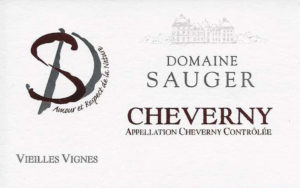
Cheverny Rouge Vieilles Vignes
Soil: Sandy clay
Climate: Oceanic with a temperate summer
Grape Varieties: Pinot Noir, Gamay, Côt (Malbec)
Harvest: Manual
Vinification: Fermentation in temperature-controlled vats for 12-20 days, remontage 1-2 times per day.
Aging: 50% of volume in barriques (1-5 years old) for 12 months, remainder in tank.
Yield: 40 hl/ha
Tasting Notes: This wine is a blend of the fresh and easy going Gamay grape and the slightly more dominant Pinot Noir. Beautiful, vibrant red color with aromas of red fruit, such as Morello cherries.
Food Pairings: Red meat, wild game, aged cheeses.
Serving Suggestion: Serve at room temperature, between 16-18°C. To be consumed within 5 years.
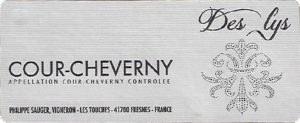
Cour-Cheverny Des Lys
Overview: Situated at the heart of France in Sologne, only a few kilometers from the greatest Chateaux in the Loire Valley such as Chambord, Cheverny, Blois, and Chenonceau, Domaine Sauger has passed from father to son for 5 generations, beginning in 1870.
Appellation: Cour-Cheverny
Grape Varieties: 100% Romorantin (local variety)
Yield: 50 Hl/Ha
Soil: Sandy clay
Climate: Oceanic with temperate summers
Harvest: Grape variety with late maturity. Manual harvest at the optimum ripeness.
Vinification: Direct pressing of the grapes with light skin maceration and temperature control to extract maximum fruit and aromas. Vinification in temperature-controlled stainless steel vats.
Tasting Notes: Romorantin expresses itself perfectly on this terroir and produces an exceptional wine with complex aromas of honey and acacia. This is a dry yet lively white wine. Subtle with good length on the finish.
Food Pairings: In its youth, this wine will accompany asparagus, fish, scallops and white meat. After a few years of aging, it will pair well with grilled poultry, lobster, or a nice slice of pan-fried foie gras.
Serving Suggestion: Serve between 8-12°C
Cellaring: 10-15 years
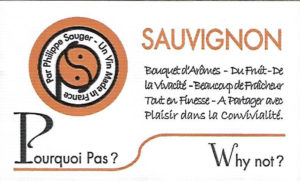
Sauvignon Blanc Pourquoi Pas?
Overview: Situated only a few kilometers from the most famous Loire Châteaux like Cheverny, Chambord, and Chenonceau, the Sauger vineyards have produced wine for generations, since 1870. They border the Sologne.
Grape Varieties: 100% Sauvignon Blanc
Yield: 90 hl/ha
Soil: Sandy clay
Climate: Oceanic with a temperate summer
Harvest: Mechanical
Vinification: Grape harvest with optimal maturity (analysis and tasting of grapes). Sorting, stemming, and direct pressing of the grapes for the most part. Maceration with skins (20-25%), static or cold settling for 12 to 24 hours. Slow fermentation at 18°C for 3 weeks in thermoregulated stainless steel tanks. No malolactic fermentation. Racking after fermentation is complete, then aging on the fine lees up until bottling.
Tasting Notes: Notes of citrus and exotic fruits in the bouquet. Fruity, fresh, and well-balanced on the palate.
Food Pairings: Seafoods, fish, shells, asparaguses, snails, or in aperitif.
Serving Suggestion: To be served between 8 and 10 degrees.
Cellaring: To drink in two years.



